Excision Surgery
New York experienced Melanoma Surgeon Dr. Monica Halem offers new advanced treatments for skin cancer Excisional Surgery.
Surgical excision is also called resection, and the borders of the entire area excised are known as the margins. Surgical excision is used to treat all types of skin cancer. At its best – given an experienced of Dr. Monica Halem and a small, well-placed tumor – it offers results that are both medically and cosmetically excellent. Dr. Halem begins by outlining the tumor with a marking pen. A “safety margin” of healthy-looking tissue will be included, because it is not possible to determine with the naked eye how far microscopic strands of tumor may have extended. The extended line of excision is drawn, so the skin may be sewn back together.
Dr. Halem will administer a local anesthetic, and then cut along the lines that were drawn. The entire procedure takes about thirty minutes for smaller lesions.
Wounds heal rapidly, usually in a week or two. Scarring depends on many factors, including the placement of the tumor and the patient’s care of the wound after the procedure.
The tissue sample will be sent to a lab, to see if any of the “safety margin” has been invaded by skin cancer. If this is the case, it is assumed that the cancer is still present, and additional surgery is required. Sometimes, Mohs micrographic surgery is a good option at this point.
In the new approach to surgery, much less of the normal skin around the tumor is removed and the margins, therefore, are much narrower than they ever were before. This spares significant amounts of tissue and reduces the need for postoperative cosmetic reconstructive surgery.
The first step in treatment is the removal of the melanoma, and the standard method of doing this is by surgical excision (cutting it out). Surgery has made great advances in the past decade, and much less tissue is removed than was customary in the past. Patients do just as well after the lesser surgery, which is easier to tolerate and produces a smaller scar.
Surgical excision is also called resection, and the borders of the entire area excised are known as the margins. In most cases, the surgery for thin melanomas can be done in our office under local anesthesia. Stitches (sutures) remain in place for one to two weeks, and most patients are advised to avoid heavy exercise during this time. Scars are usually small and improve over time.
Discolorations and areas that are depressed or raised following the surgery can be concealed with cosmetics specially formulated to provide camouflage. If the melanoma is larger and requires more extensive surgery, a better cosmetic appearance can be obtained with flaps made from skin near the tumor, or with grafts of skin taken from another part of the body. For grafting, the skin is removed from areas that are normally or easily covered with clothing.
There is now a trend towards performing sentinel node biopsy and tumor removal surgery at the same time, provided the tumor is 1 mm or more thick. When the procedures are combined in this way, the patient is spared an extra visit.
What is Melanoma?
The most dangerous form of skin cancer, these cancerous growths develop when unrepaired DNA damage to skin cells (most often caused by ultraviolet radiation from sunshine or tanning beds) triggers mutations (genetic defects) that lead the skin cells to multiply rapidly and form malignant tumors. These tumors originate in the pigment-producing melanocytes in the basal layer of the epidermis. Melanomas often resemble moles; some develop from moles. The majority of melanomas are black or brown, but they can also be skin-colored, pink, red, purple, blue or white. Melanoma is caused mainly by intense, occasional UV exposure (frequently leading to sunburn), especially in those who are genetically predisposed to the disease. Melanoma kills an estimated 9,940 people in the US annually.
If melanoma is recognized and treated early, it is almost always curable, but if it is not, the cancer can advance and spread to other parts of the body, where it becomes hard to treat and can be fatal. While it is not the most common of the skin cancers, it causes the most deaths. The American Cancer Society estimates that at present, more than 135,000 new cases of melanoma in the US are diagnosed in a year. In 2015, an estimated 73,870 of these will be invasive melanomas, with about 42,670 in males and 31,200 in women.
Warning Signs: The ABCDEs of Melanoma
Moles, brown spots and growths on the skin are usually harmless — but not always. Anyone who has more than 100 moles is at greater risk for melanoma. The first signs can appear in one or more atypical moles. That’s why it’s so important to get to know your skin very well and to recognize any changes in the moles on your body. Look for the ABCDE signs of melanoma, and if you see one or more, make an appointment with a physician immediately.
A – ASYMMETRY
Common, benign moles look the same over time. Be on the alert when a mole starts to evolve or change in any way. When a mole is evolving, see a doctor. Any change — in size, shape, color, elevation, or another trait, or any new symptom such as bleeding, itching or crusting — points to danger.
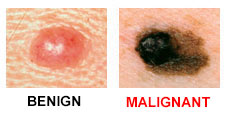
This benign mole is not asymmetrical. If you draw a line through the middle, the two sides will match, meaning it is symmetrical. If you draw a line through this mole, the two halves will not match, meaning it is asymmetrical, a warning sign for melanoma.
B – BORDER
A benign mole has smooth, even borders, unlike melanomas. The borders of an early melanoma tend to be uneven. The edges may be scalloped or notched.
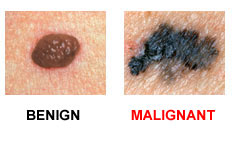
C – COLOR
Most benign moles are all one color— often a single shade of brown. Having a variety of colors is another warning signal. A number of different shades of brown, tan or black could appear. A melanoma may also become red, white or blue.
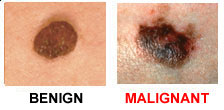
D- DIAMETER
Benign moles usually have a smaller diameter than malignant ones. Melanomas usually are larger in diameter than the eraser on your pencil tip (¼ inch or 6mm), but they may sometimes be smaller when first detected.
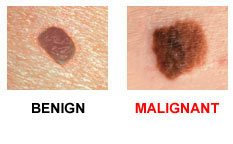
E – EVOLVING
Common, benign moles look the same over time. Be on the alert when a mole starts to evolve or change in any way. When a mole is evolving, see a doctor. Any change — in size, shape, color, elevation, or another trait, or any new symptom such as bleeding, itching or crusting — points to danger.
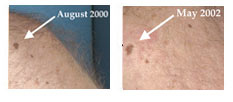
For patients undergoing Excision Surgery in our New York office please download Excision Surgery Pre-Op Instructions here.
If you have been diagnosed with skin cancer, please call our office to schedule your consultation with Dr. Halem. Our caring and experienced professional staff work hard to continually exceed expectations and are always eager to help with any questions or concerns you may have.













